Indexing & Abstracting
Full Text
Research ArticleDOI Number : 10.36811/ijho.2021.110008Article Views : 31Article Downloads : 18
Thyroid cancer in persons as a result of the Chernobyl accident
Alexander N. Stojarov1, Aleksey E. Okeanov2, Vladislav V. Khrustalev3* and Alesia A. Yaumenenka4
1Professor, Department of Radiation Medicine and Ecology, Belarusian State Medical University, 220116, Minsk, Belarus, Tel:+375297560223; Email: stojarov@mail.ru
2Professor, State Institution «N.N. Alexandrov National Cancer Center of Belarus», 223040, Lesnoy, Belarus, Tel: +375293382850; Email: okeanov@nsys.by
3Head of Department of General Chemistry, Belarusian State Medical University, 220116 Minsk, Belarus, Tel: +375296487795; Email: vvkhrustalev@mail.ru
4Assistant of Professor, State Institution «N.N. Alexandrov National Cancer Center of Belarus», 223040, Lesnoy, Belarus, Tel: 375296722641; Email: evmenenkoalesya88@gmail.com
*Corresponding Author: Vladislav V. Khrustalev, Head of Department of General Chemistry, Belarusian State Medical University, 220116 Minsk, Belarus, Tel: +375296487795; Email: vvkhrustalev@mail.ru
Article Information
Aritcle Type: Research Article
Citation: Alexander N. Stojarov, Aleksey E. Okeanov, Vladislav V. Khrustalev, et al. 2021. Thyroid cancer in persons as a result of the Chernobyl accident. Int J Hematol Oncol. 4: 01-11.
Copyright: This is an open-access article distributed under the terms of the Creative Commons Attribution License, which permits unrestricted use, distribution, and reproduction in any medium, provided the original author and source are credited. Copyright © 2021; Alexander N. Stojarov
Publication history:
Received date: 02 February, 2021Accepted date: 15 February, 2021
Published date: 16 February, 2021
Abstract
This study analyzed the sex and age characteristics of the incidence of thyroid cancer between residents of contaminated and not contaminated by the iodine-131 districts of Belarus in whom thyroid cancer was registered from 1986 to 2016. The analysis was carried out according to the data of the Belarusian Cancer Register and was focused on the age groups of 0-4, 5-9, 10-14, and 15-18 years old as of April 1986, i.e. at the time of the Chernobyl accident. The control group of patients was taken from the Lepel district of the Vitebsk region, which was not contaminated with iodine isotopes . The shortest latency period until the onset of the disease (16 years) was found for the 0-4 years old group. There are no significant gender differences in latency time and the age of diagnosis of thyroid cancer. In general, the incidence rates of thyroid cancer in the Brest region are higher than in the Vitebsk region, where there was practically no radioactive fallout of iodine-131. Comparison of the incidence in the Brest region with the nationwide one showed its decrease in 2006-2010, that can be explained by different latency periods of different age groups and the characteristics of radiation exposure. The data obtained supports the hypothesis of the radiation-induced nature of thyroid cancer due to the exposure of the population to radioactive iodine in April 1986.
Introduction
Despite the fact that more than 33 years have passed since the accident at the Chernobyl nuclear power plant, its medical consequences are still in the center of attention of world experts. The increase in the incidence rate of thyroid cancer (TC) in populations of Belarus, Ukraine, and Russia exposed to radioactive iodine (I-131) immediately after the disaster has been confirmed in several studies [1-3]. However, the data on this phenomenon are characterized by a number of uncertainties. Firstly, the changed economic and social conditions in those republics due to the collapse of the USSR in 1991 could have an impact on the change of the incidence rate. Second, there was a lack of coordinated research approaches to the registration of cancer. Third, the dosimetry base, which is absolutely necessary to establish the effects of radiation, was too small. Therefore, the International Agency for Research on Cancer made a proposal to unite the efforts of specialists in the study of this pathology [4].
An important contribution to the analysis of data on the incidence of thyroid cancer in post-Soviet countries was made by the white paper of the UN Scientific Committee on the Effects of Atomic Radiation (UNSCEAR) published in 2018 [5]. This white paper does not just describe the data on this pathology in the post-Chernobyl period, but also formulates the perspectives for further scientific research. The present study was undertaken within these perspectives.
Methods
The analysis included the data from the Belarusian Cancer Register on residents of rural settlements of Stolin and Luninets districts of the Brest region, who were diagnosed with thyroid cancer in the period from 1986 to 2016. The choice of such a cohort was associated with the radiation exposure of residents immediately after the Chernobyl accident. The radiation cloud, including a mixture of iodine radionuclides, passed over the territory of the Brest region in the night of April 26, 1986. This led to radioiodine contamination of the territories of Stolin and Luninets districts, where surface activity of I-131 ranged from 15 to 100 Ci/sq.km (Figure 1) [6]. The intake of this radionuclide into the body occurred by inhalation and also alimentary due to the consumption of whole milk. I-131 accumulated almost exclusively in the thyroid gland, forming an absorbed dose for this organ. The inclusion of rural residents in the study is due to their low migration activity. It is known that the main direction of migration in rural areas is associated with moving to a larger settlement (district center, town, city). Reverse migration is negligible. Consequently, if a person was living in a rural area when the diagnosis was made, then it can be assumed that in previous years he had been living in the same location.
The Lepel district of the Vitebsk region was selected for a comparison. This area was practically not contaminated with iodine radionuclides and, therefore, the population did not receive doses to the thyroid gland (Figure 1). Statistical data processing was carried out using the applied computer programs STATISTICA 10.0 (Statsoft Inc., Australia) and SIGMA PLOT 12.5 (Systat Software Inc, Germany). The reliability of the results was assessed using the SigmaPlot program by the value p < 0.05.
This study was approved by the Ethics Commission of the Belarusian Association of Physicians (10.12.2020).
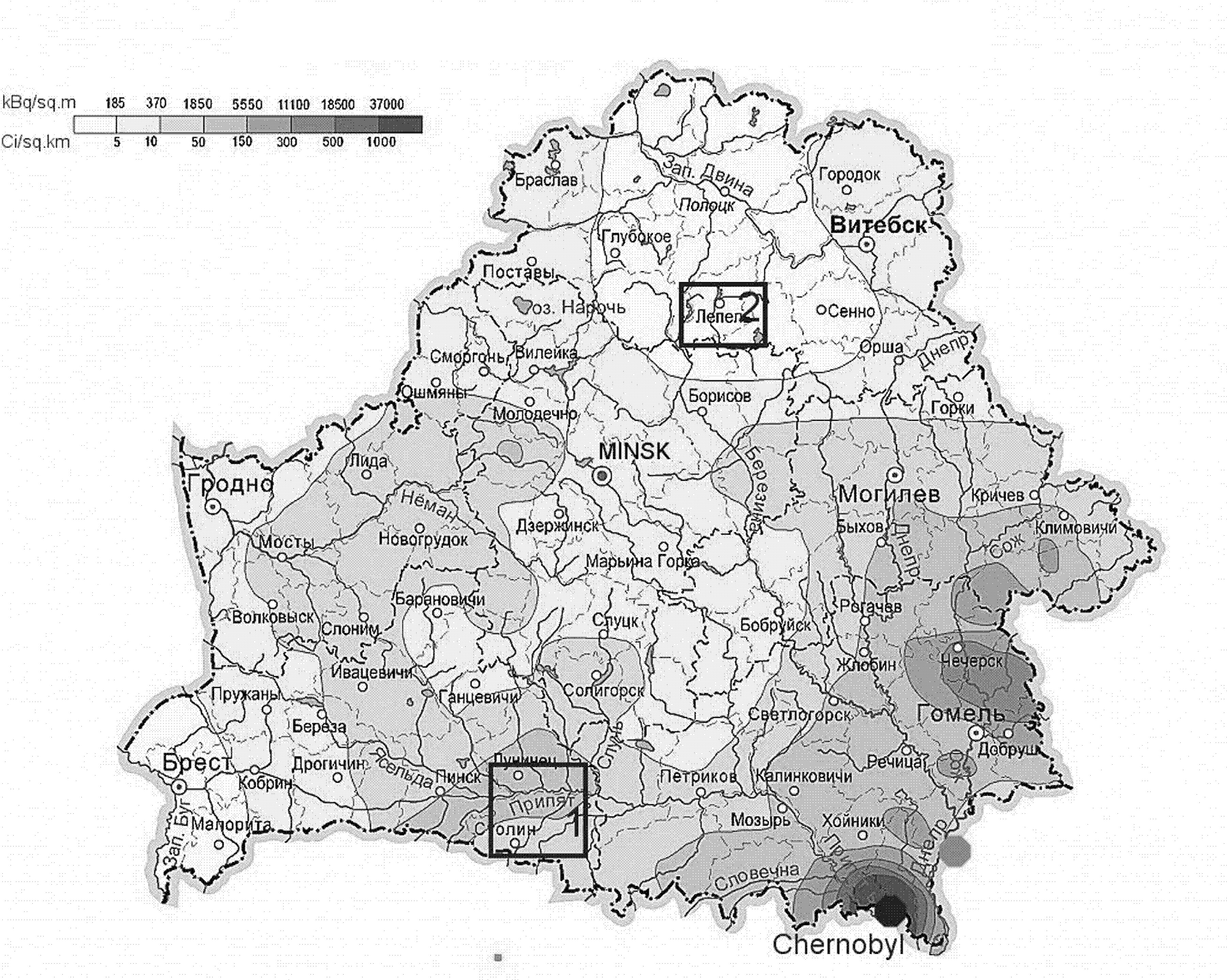
Figure 1: Reconstructed map of contamination of the territory of Belarus by I-131 (as of May 10, 1986). Note: 1 - the territory of the Stolin and Luninets districts of the Brest region; 2 - the territory of the Lepel district of the Vitebsk region.
Results
Due to the peculiarities of the formation of absorbed doses in the thyroid gland in childhood, when large doses are formed in this population group, as well as in the context of the design of the analysis of the incidence of thyroid cancer that was provided in the UNSCEAR white paper [5], the entire population from the districts of Brest oblasts were divided into several age groups at the time of the Chernobyl accident, i.e. April 1986: 0-4 years old, 5-9 years old, 10-14 years old, 15-18 years old. All analyzed indicators were calculated for these age groups. Table 1 shows the data on the descriptive statistics of patients from Luninets and Stolin districts of the Brest region diagnosed with thyroid cancer depending on their age.
It is clearly seen that the younger the age at which the exposure to radioactive iodine happened, the shorter the latent period of the development of this disease. So in the age group of 0-4 years old, the latency period is 16 years, while irradiation at the age from 15 to 18 years led to the onset of cancer only after 25 years (on average).
These changes are well confirmed by the following fact. There is a linear dependence between the average age in age groups at the time of the disaster and the age at the time of diagnosis of thyroid cancer, expressed by the linear regression equation (Figure 2).
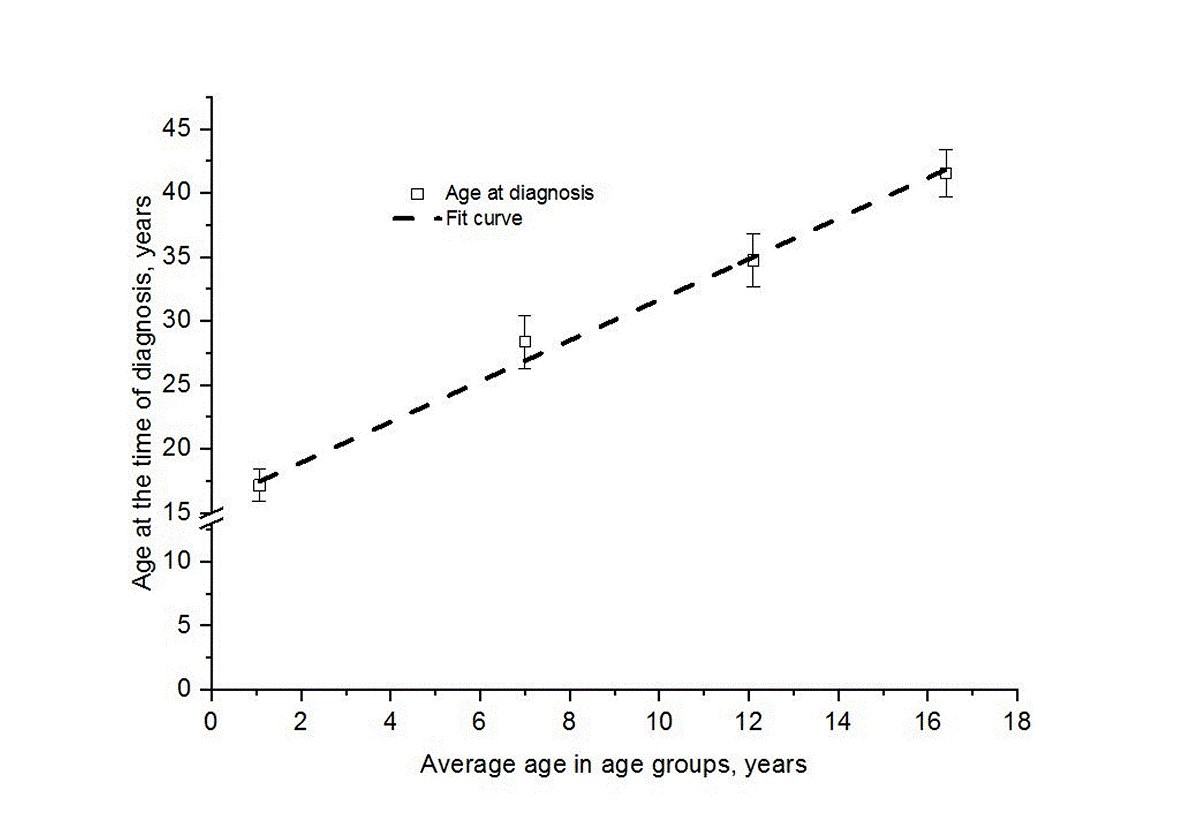
Figure 2: Relationship between age groups at the time of the disaster and the age at the time of diagnosis. Linear Fit.
|
Table 1: Descriptive statistics of age groups of rural residents from Stolin and Luninets districts of the Brest region with a confirmed diagnosis of TC. |
|||||
|
Age groups |
|||||
|
Index |
0-4 years (n=44) |
5-9 years (n=23) |
10-14 years (n=23) |
15-18 years (n=19) |
|
|
Age in April 1986, years |
M±m |
1.07±0.19 |
7.0±0.31 |
12.1±0.28 |
16.42±0.25 |
|
Median |
1 |
5 |
12 |
17 |
|
|
Age at the time of diagnosis, years |
M±m |
17.16±1.25 |
28.35±2.07 |
34.74±2.03 |
41.53±1.82 |
|
Median |
14.5 |
31 |
39 |
45 |
|
|
Latent period, years |
M±m |
15.6±1.20 |
20.91±1.90 |
22.0±2.02 |
24.6±1.81 |
|
Median |
13 |
24 |
28 |
28 |
|
|
Note: TC – thyroid cancer. |
|||||
In other words, the older the individual was at the time of exposure to radioiodine, the later the discovery of thyroid cancer can be expected. However, it is necessary to find out whether this dependence is related to the fact of exposure itself.
Due to a small number of patients in the Lepel district of the Vitebsk region (the number of thyroid cancer cases in 30 years was equal to just thirty cases), we could not identify more or less full-fledged age groups, so we analyzed this dependence on the absolute number of cases of the diagnosed disease. Figure 3 shows the relationship between the age of patients in April 1986 and the age at the time of diagnosis of thyroid cancer in the studied regions of Belarus. It is clearly seen that there are no significant differences between the indicated parameters, both according to the data on the Brest region and the Lepel district, which is expressed in a linear dependence of the same parameters. In other words, if April 1986 (the moment of the Chernobyl accident) is taken as the point of the report, then for each age there is a certain latency period before the onset of the disease.
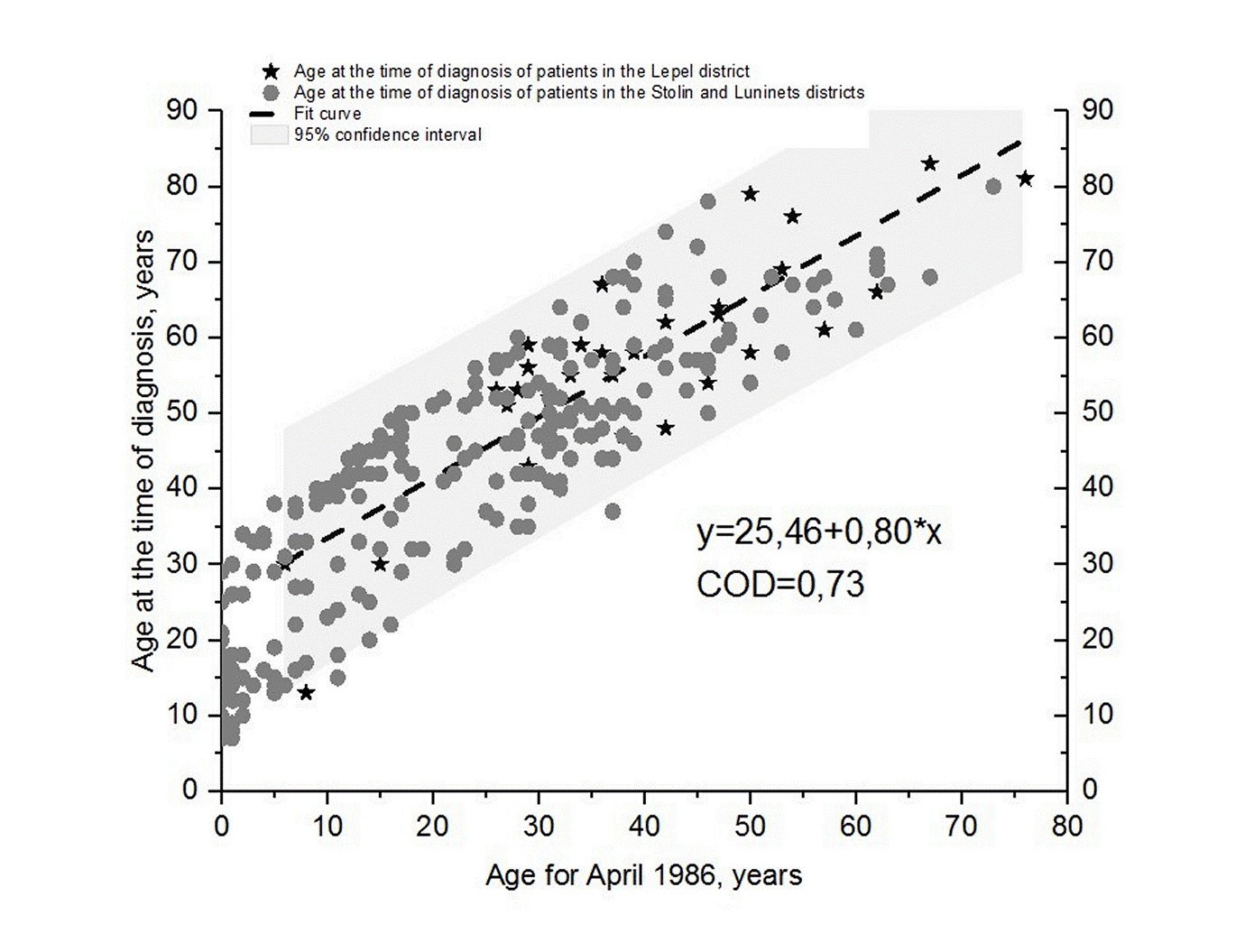
Figure 3: The relationship between the age of individuals at the time of the Chernobyl accident (April 1986) and the age at diagnosis of thyroid cancer. Linear Fit. COD - Determination coefficient.
In the next series of studies, it seemed interesting to analyze the gender differences in the mentioned age groups. Table 2 and Figure 4 show descriptive statistics of gender differences in age groups of residents of two districts of the Brest region. It is clearly seen that there are no significant gender differences with the exception of the group 10-14 years. In these group, at the time of diagnosis, females were significantly older than males. Women also had a longer latency period for the onset of this disease (25 versus 13 years).
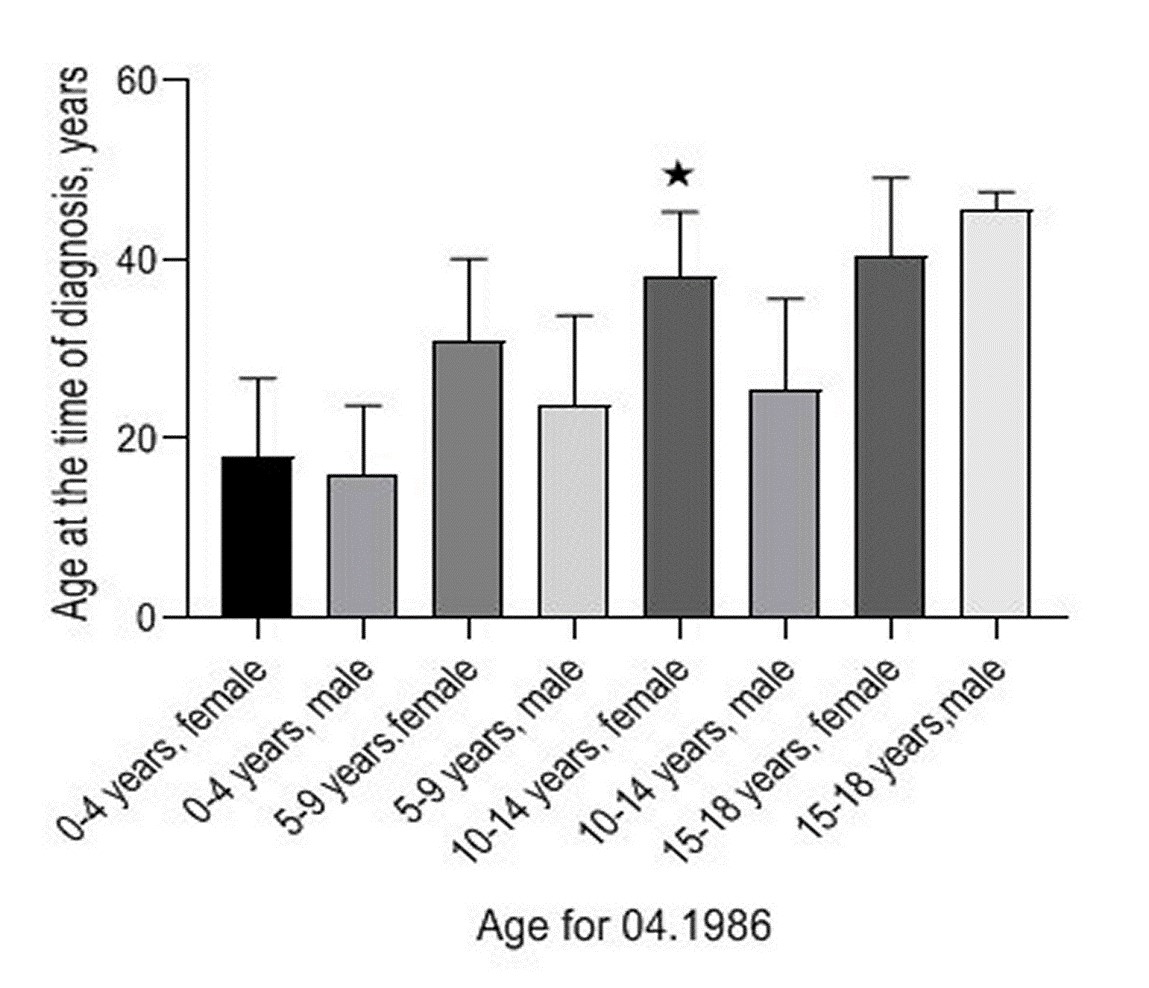
Figure 4: Influence of gender in the age groups on the age of diagnosis of thyroid cancer. The asterisk denotes statistically significant differences between men and women in the age group 10-14 years (P = 0,003).
|
Table 2: Descriptive statistics of sex differences in age groups of rural residents of Stolin and Luninets districts of the Brest region with a diagnosis of TC. |
||||||
|
Age groups |
||||||
|
|
Gender |
Index |
0-4 years |
5-9 years |
10-14 years |
15-18 years |
|
Age at the time of diagnosis, years |
Female |
M±m |
17.9±1.7 (n=26) p1 = 0.470 |
30.8±2.4 (n=15) p1 = 0.108 |
38.1*±1.8 (n=17) p1 = 0.003 |
40.5±2.2 (n=15) p1 = 0.271 |
|
Median |
15.5 |
33 |
41 |
42 |
||
|
Male |
M±m |
16.1±1.8 (n=18) |
23.8±3.5 (n=8) |
25.3±4.2 (n=6) |
45.5±1.0 (n=4) |
|
|
Median |
13.5 |
23 |
22 |
45.5 |
||
|
Latent period, years |
Female |
M±m |
16.2±1.7 (n=26) p2 = 0.578 |
22.9±2.4 (n=15) p2 = 0.165 |
25.4*±1.8 (n=17) p2 = 0.003 |
23.5±2.2 (n=15) p2 = 0.275 |
|
Median |
13 |
25 |
29 |
26 |
||
|
Male |
M±m |
14.8±1.6 (n=18) |
17.3±3.0 (n=8) |
12.5±4.0 (n=6) |
28.5±1.0 (n=4) |
|
|
Median |
13 |
16.5 |
9 |
29 |
||
|
Note: p1 - significance of differences in age at the time of diagnosis between women and men in the respective age groups. p2 - significance of differences in latent period between women and men in the respective age groups. p-value was calculated based on t-test. TC – thyroid cancer. Significant difference between genders is shown by the asterisk (*). |
||||||
It was not possible to compare the features of the occurrence of thyroid cancer in the age groups of the Brest region and the Lepel district of the Vitebsk region due to the paucity of data, since among the 30 cases of thyroid cancer in the Lepel district in the age group over 18 years old there was an overwhelming number of cases.
Indicators calculated per 100,000 population in two districts of the Brest region and the uncontaminated Lepel district of the Vitebsk region also showed significant features in the incidence rate of thyroid cancer in the population exposed to radiation (Figure 5).
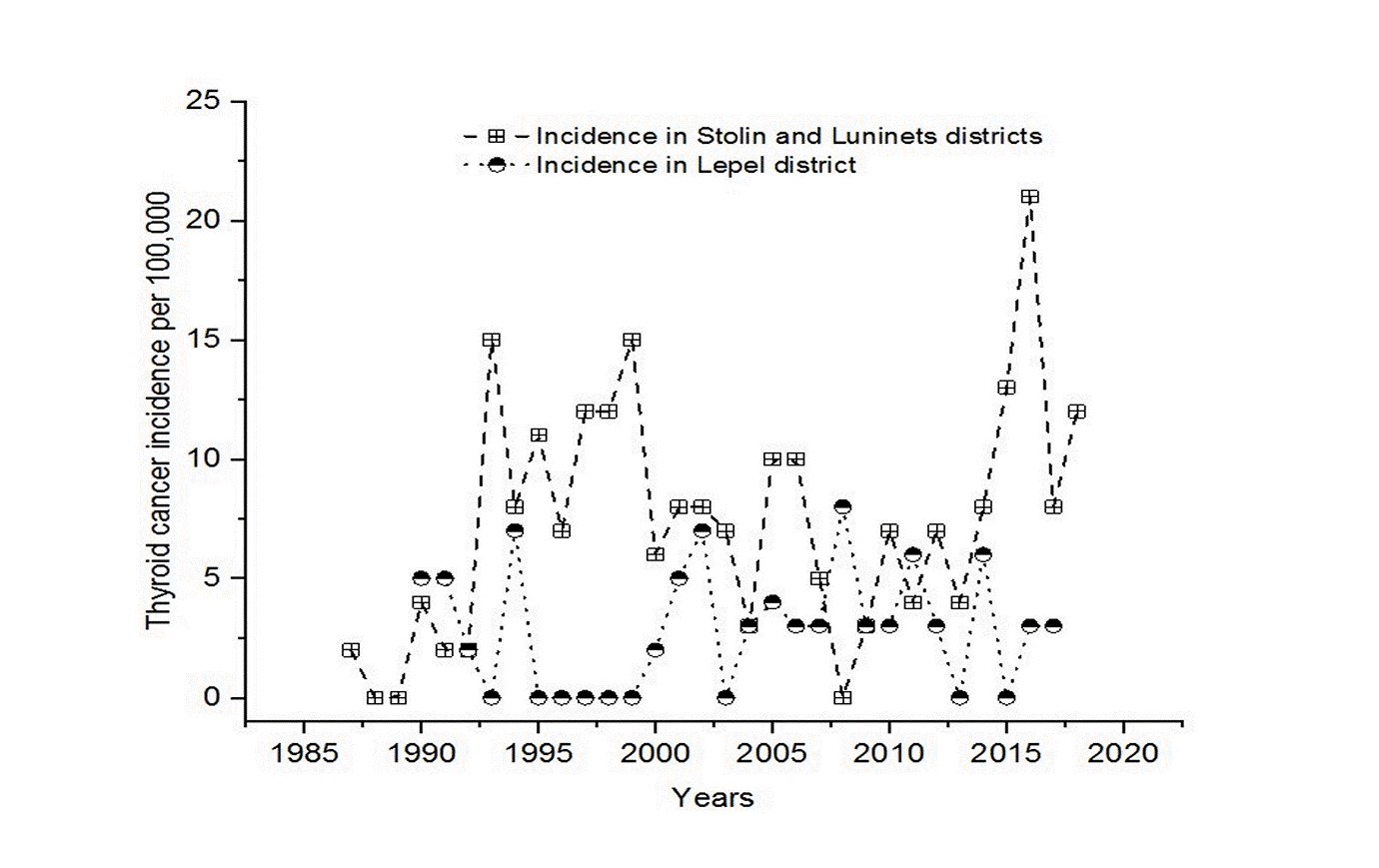
Figure 5: Dynamics of thyroid cancer incidence rates in Stolin and Luninets districts of the Brest region and the Lepel district of the Vitebsk region. Sample from the cancer register of the contaminated Stolin and Luninets districts and the uncontaminated Lepel district for 1986-2016.
Over the 30-years observation period, the incidence in the Brest region was higher and this fact can be explained with a high degree of probability by the radiation effect on the population living there.
It is of interest to compare the incidence of thyroid cancer in the affected areas with the average incidence in Belarus. Figure 6 shows the incidence rates of thyroid cancer in persons who were at the time of the accident in the age of 0-18 years old in two districts of the Brest region and in the republic as a whole. The data were calculated for the entire population of all districts of the republic. It can be noted that in different years the incidence of persons of both sexes, expressed per 100,000 population, in Stolin and Luninets districts of the Brest region is higher than the average in the whole republic. This difference is especially evident in the first 14 years after the Chernobyl accident. Then there is a decline in the incidence, and after 20-24 years, the incidence of thyroid cancer in the affected areas is less than in the whole country. Later, the original ratio is restored.
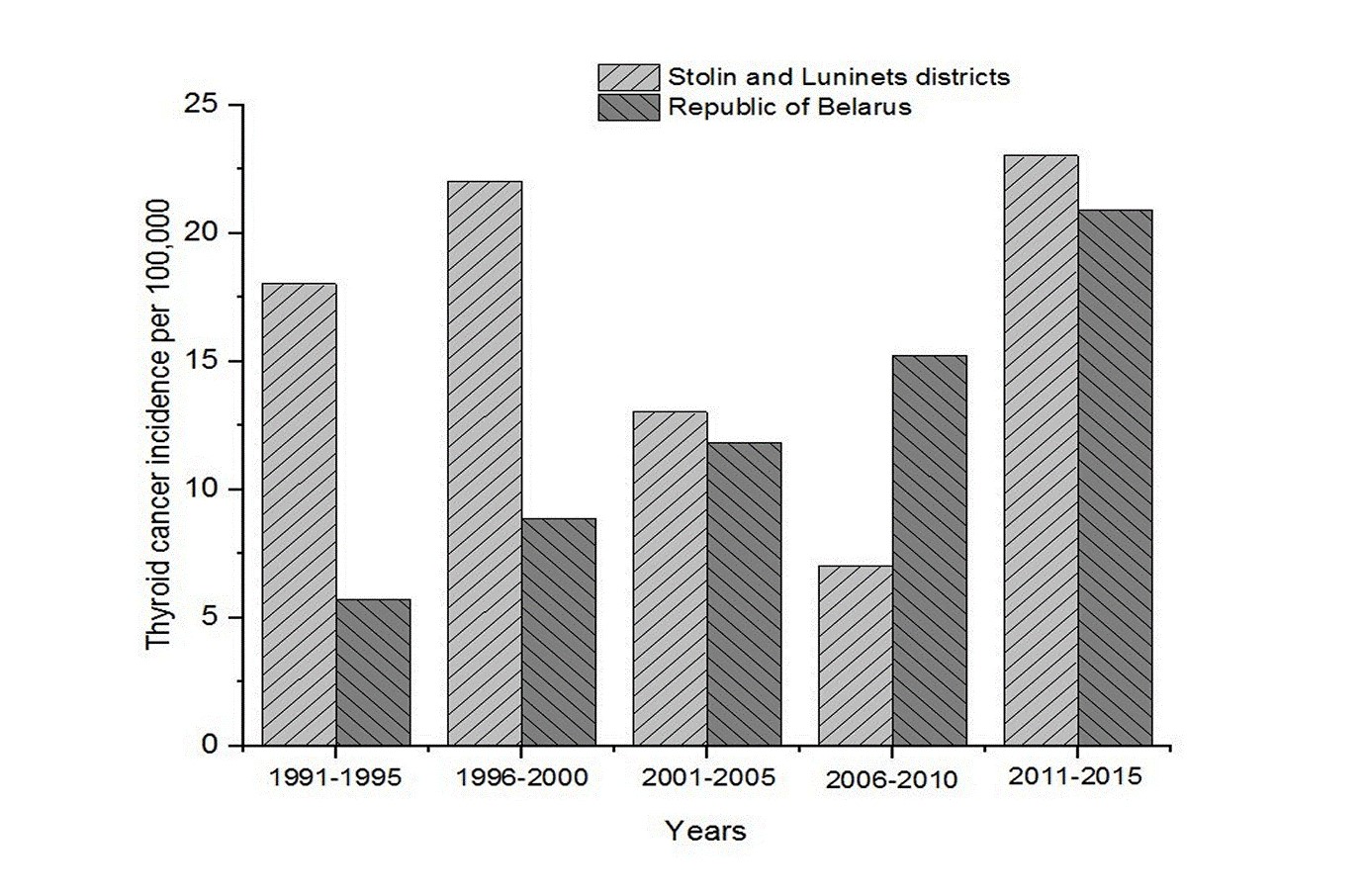
Figure 6: The incidence of thyroid cancer in different periods of time in the affected areas of the Brest region and in the country as a whole.
In general, if we consider the dynamics of the incidence of thyroid cancer in Belarus for persons who in April 1986 were from 0 to 18 years old, then one can notice a rather significant increase in this pathology in females over the next 30 years and a less pronounced tendency to the increase in the incidence in men (Figure 7).
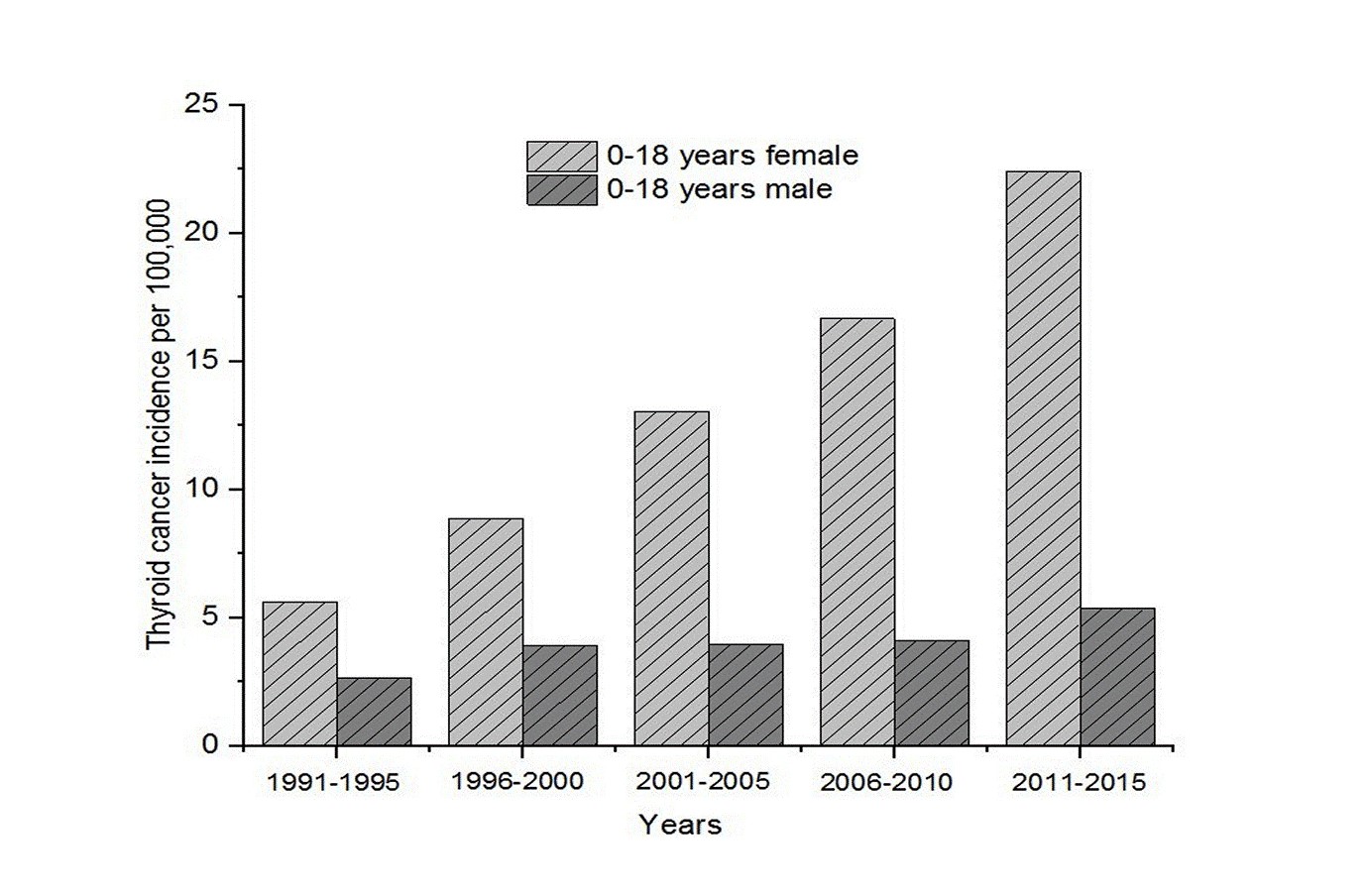
Figure 7: Dynamics of thyroid cancer incidence in the population of Belarus, who in April 1986 were from 0 to 18 years old.
Discussion
In the present study, it was found that the latent period of thyroid cancer even in the youngest age group (0-4 years) is about 16 years. In this regard, the data on the growth of thyroid cancer incidence in children in Belarus 4-5 years after the Chernobyl disaster seem to be very interesting and incomprehensible [1]. One of the reasons, which was mentioned earlier, may be the degree of radiation exposure due to the incorporation of iodine by the thyroid gland of a smaller mass, i.e. absorbed doses in children were larger than those in adults. Nevertheless, this issue requires a separate careful consideration.
The fact of the similarity of the relationships between the age of patients in April 1986 and the age at the time of diagnosis for both contaminated (Stolin and Lunintsky) and uncontaminated (Lepel) regions is very interesting. In the last region there was practically no contamination by the radioactive iodine and, therefore, the population was not exposed to radiation, and the development of the thyroid cancer has no connection with the deposition of radioactive iodine. Nevertheless, the older the patients were, the later they had thyroid cancer. Obviously, the radiation effect does not affect the mentioned dependence. However, one circumstance should be taken into account here. The latent period of the onset of the thyroid cancer may be related to the magnitude of the absorbed dose in this endocrine organ. But, as mentioned above, this fact needs additional, mandatory verification.
The data on the absence of gender differences in age groups in relation to the age of diagnosis and the latency period of the disease, excluding the group of 10-14 years, are very interesting. From our point of view, these changes can be explained by the peculiarities of the pubertal period, during which those persons were exposed to irradiation because of incorporation of radioactive iodine by their thyroid glands. In addition, the features of the endocrine system of women can play an important role in the induction of this pathology.
It is rather difficult to explain the failure of thyroid cancer incidence 20 years after the accident (Fig. 5). However, if we refer to the data in Table 1, we can see that the age of the onset of the disease in the youngest age group (0-4 years) at which thyroid cancer begins is expected after 17 years. Consequently, it is in this group that approximately in 2003 an increased incidence rate should be detected (compared to the nationwide), i.e. 1986 + 17 years = 2003. This is reflected in the graph in the third group of columns for 2001-2005. As one can see in the same Table 1, the gap between the youngest and the next age group of 5-9 years in which thyroid cancer is diagnosed is 11 years. Therefore, the maximum growth of this pathology should be expected in 2014, which is confirmed by the data from Figure 5 (the fifth group of bars in the diagram). That is: 1986 + 28 years = 2014. A decline in the registration of this oncopathology should be expected between these periods. Following this assumption, in the next age groups 10-14 and 15-18 years, the maximum number of diagnosed cases will be in 2021 and 2027, respectively. It can also be assumed that the significant prevalence of morbidity in districts of the Brest region over the national one for 1991-2000 can be explained by the intensity of radiation exposure to the population, i.e. the formation of significant absorbed doses in the thyroid gland in individuals of different age groups, which has already been discussed earlier. However, this assumption needs additional verification.
Thus, summarizing the data presented, we can conclude that the impact of radioactive iodine emitted as a result of the Chernobyl accident is a factor stimulating the growth of thyroid cancer in the affected areas, which is not observed in areas that were not contaminated by this radionuclide. There is a linear dependence between the age at the exposure and the age at diagnosis. However, the role of radiation exposure in this phenomenon can be excluded. There are no significant gender differences in the incidence of thyroid cancer, with the exception of the groups of people who were 5-9 and 10-14 years at the moment of Chernobyl accident. In this group, the age at the time of diagnosis was significantly higher in females than in males. In general, in the republic, the incidence of thyroid cancer in the group of people who in April 1986 were from 0 to 18 years old is less than in people from affected districts of the Brest region, which again can be explained by the impact on the population of radioactive iodine isotopes.
Acknowledgments
The authors are grateful to the head of the Department of Epidemiology of the Belarusian State Medical University, Professor Chistenko G.N. for valuable advice when discussing research materials.
References
1. Kazakov V, Demidchik E , Astakhova L. 1992. Thyroid cancer after Chernobyl. Nature. 359: 21. Doi: http://dx.doi.org/10.1038/359021a0
2. Astakhova L, Anspaugh L, Beebe G, et al. 1998. Chernobyl-related thyroid cancer in children of Belarus: a case-control study. Radiat Res. 150: 349-356. Ref.: https://pubmed.ncbi.nlm.nih.gov/9728663/ Doi: http://dx.doi.org/10.2307/3579983
3. Ron E. 2007. Thyroid Cancer Incidence Among People Living in Areas Contaminated by Radiation From the Chernobyl Accident. Health Phys. 93: 502-511. Ref.: https://pubmed.ncbi.nlm.nih.gov/18049226/ Doi: http://dx.doi.org/10.1097/01.HP.0000279018.93081.29
4. Ostroumova E, Schüz J, Kesminiene A. 2020. Future of Chernobyl research: the urgency for consolidated action. The Lancet. 395: 1037-1038. Doi: http://dx.doi.org/10.1016/S0140-6736(20)30675-9
5. UNSCEAR (United Nations Scientific Committee on the Effects of Atomic Radiation) (2018). New York: Evaluation of data on thyroid cancer in regions affected by the Chernobyl accident: A white paper to guide the Scientific Committee’s future programme of work. 20.
6. Germenchuck M. 2000. PhD thesis. Reconstruction of radioactive contamination of the territory of Belarus by Iodine-131 after the cat?strophe on Chernobyl NPP. Minsk. Ref.: http://rad.org.by/public/I_1986.jpg




















